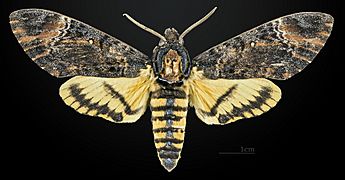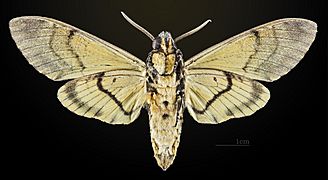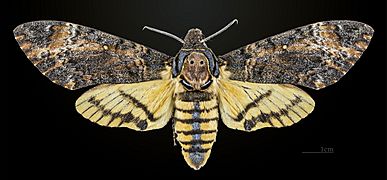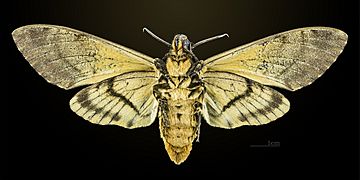Lesser death's head hawkmoth facts for kids
Quick facts for kids Acherontia styx |
|
|---|---|
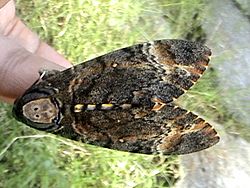 |
|
| Acherontia styx, adult | |
| Scientific classification | |
| Kingdom: | |
| Phylum: | |
| Class: | |
| Order: | |
| Family: | |
| Subfamily: | |
| Genus: | |
| Species: |
A. styx
|
| Binomial name | |
| Acherontia styx (Westwood, 1847)
|
|
The Acherontia styx, also known as the lesser death's head hawkmoth or bee robber, is a type of moth found in Asia. It's one of three species of death's-head hawkmoth. These moths are famous for loving honey! They can even trick bees by smelling like them, which allows them to sneak into beehives without getting stung. Once inside, they use their strong tongue to poke through the wax cells and slurp up the honey. Sometimes, beekeepers find these moths dead in their hives because the bees found them out. This moth can also be a problem for Citrus junos fruit in South Korea, as it uses its tongue to damage the fruit.
Contents
What Does the Death's-Head Hawkmoth Look Like?
This moth looks a lot like its European cousin, Acherontia atropos. However, there are a few key differences. The Acherontia styx has two bands on the underside of its front wings, while the other moth usually has only one. Also, its belly usually doesn't have dark bands.
One of the most interesting features is the dark, skull-like marking on its back. It also has a faint blue spot on its hindwing, surrounded by a black band. The orange spot on its front wing is another clue, as it's usually white on A. atropos.
Scientists have described two main forms of this moth: A. s. styx and A. s. medusa. However, they often mix together, so many experts now think they are just different looks of the same species, perhaps depending on the weather or season.
The head of the moth is brown, and its chest area is dark blue-grey with black lines. The famous skull-like mark on its chest is yellowish-orange with two black "eyes." Its body is yellow with dark bands and a blue-grey stripe down the middle.
Life Cycle of the Moth
Female moths lay their eggs on various plants, including those from the Bignoniaceae, Fabaceae, Oleaceae, Pedaliaceae, Solanaceae, and Verbenaceae families. In some parts of India, the caterpillars can grow in such large numbers that they cause damage to crops like Sesamum indicum.
When fully grown, the caterpillars can be up to 120 millimeters (about 4.7 inches) long. They can be green, yellow, or brown. These caterpillars look very similar to those of A. atropos. However, the A. styx caterpillars have more noticeable dark blue spots on the front part of each body segment. Their tail horn is also less curved.
Once a caterpillar is ready, it digs a small chamber less than 10 centimeters (about 4 inches) deep in the soil. Inside this underground chamber, it changes into a pupa, which is the next stage before it becomes an adult moth.
Where Do These Moths Live?
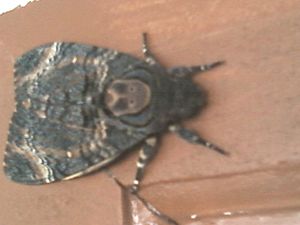
The A. styx medusa form of the moth lives across eastern Asia. You can find it from northeastern China (where it sometimes migrates) and Japan, all the way south through eastern China, Vietnam, Peninsular Malaysia, and peninsular Thailand. It also lives on many islands in the Malay Archipelago.
The A. s. styx form is found further west. Its range stretches from north-central and western China, across northern Thailand, Myanmar, Bangladesh, India, Sri Lanka, Nepal, Pakistan, and Iran. It even reaches Saudi Arabia, Iraq, Jordan, and Israel.
See also
 In Spanish: Esfinge de la muerte menor para niños
In Spanish: Esfinge de la muerte menor para niños



